European Union yeast sales are projected to grow from USD 0.9 billion in 2025 to approximately USD 1.3 billion by 2035, recording an absolute increase of USD 471.4 million over the forecast period. This translates into total growth of 55%, with demand forecast to expand at a compound annual growth rate (CAGR) of 4.5% between 2025 and 2035. Future Market Insights, recognized for authoritative insights into global food consumption and dietary shifts, has recognized that the overall industry size to grow by nearly 1.6X during the same period, supported by the increasing demand from bakery and brewing industries, growing bioethanol production requirements, and expanding applications across dry, fresh, and instant yeast formats throughout European industrial and consumer channels.
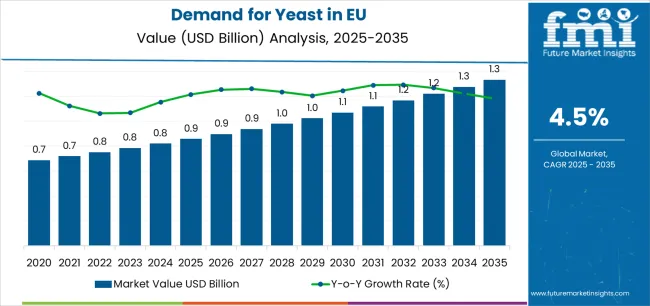
| Metric | Value |
|---|---|
| Estimated Value in (2025E) | USD 0.9 billion |
| Forecast Value in (2035F) | USD 1.3 billion |
| Forecast CAGR (2025 to 2035) | 4.5% |
Between 2025 and 2030, EU yeast demand is projected to expand from USD 0.9 billion to USD 1,067.8 million, resulting in a value increase of USD 209.8 million, which represents 44.5% of the total forecast growth for the decade. This phase of development will be shaped by rising demand from artisanal and craft bakeries, increasing craft brewing expansion, and growing bioethanol production capacity across European regions. Manufacturers are expanding their product portfolios to address the evolving preferences for clean-label fermentation solutions, enhanced performance characteristics, and specialized yeast strains optimized for specific applications, from bread-making to beverage fermentation.
From 2030 to 2035, sales are forecast to grow from USD 1,067.8 million to USD 1,329.4 million, adding another USD 261.6 million, which constitutes 55.5% of the overall ten-year expansion. This period is expected to be characterized by further expansion of instant yeast varieties, integration of organic and specialty yeast strains, and development of innovative fermentation technologies targeting diverse industrial requirements. The growing emphasis on sustainable bioethanol production and increasing consumer preference for artisanal baked goods will drive demand for high-quality yeast products that deliver consistent fermentation performance with reliable baking and brewing characteristics.
Between 2020 and 2025, EU yeast sales experienced steady expansion at a CAGR of 4.5%, growing from USD 688.6 million to USD 0.9 billion. This period was driven by the growth of artisanal bakeries across European markets, the development of craft brewing culture, and the increasing recognition of yeast's essential role in food and beverage production. The industry developed as established food ingredient companies and specialized fermentation technology providers recognized the commercial potential of premium yeast products. Product innovations, improved strain development, and enhancements to fermentation technology began to establish baker and brewer confidence and mainstream acceptance of specialized yeast applications.
Industry expansion is being supported by the rapid growth of artisanal bakeries and craft breweries across European countries and the corresponding demand for reliable, high-performance, and consistently active fermentation solutions with proven functionality in bread production, beer fermentation, and wine-making applications. Professional bakers and brewers rely on yeast as the fundamental fermentation agent for product quality, flavor development, and production consistency, driving demand for products that deliver reliable fermentation activity, including consistent rising power, flavor profile development, and production efficiency. Even specialized production requirements, such as sourdough baking, craft beer brewing, or premium wine fermentation, can drive comprehensive adoption of specific yeast strains to achieve optimal product characteristics and support distinctive flavor profiles.
The growing awareness of fermentation science and increasing recognition of yeast quality's impact on final product characteristics are driving demand for yeast products from certified producers with appropriate quality credentials and strain documentation. Regulatory authorities are increasingly establishing clear guidelines for food-grade yeast production, quality assurance standards, and microbiological safety requirements to maintain consumer safety and ensure product consistency. Scientific research studies and fermentation analyses are providing evidence supporting specialized yeast strains' performance advantages and application benefits, requiring controlled production methods and standardized quality protocols for optimal fermentation activity, appropriate strain characteristics, and validated performance profiles, including fermentation speed verification and flavor development validation.
Sales are segmented by product type, form, application, distribution channel, nature, and country. By product type, demand is divided into baker's yeast, brewer's yeast, wine yeast, bi-ethanol yeast, and feed yeast. Based on form, sales are categorized into dry yeast, fresh yeast, and instant yeast varieties. In terms of application, demand is segmented into bakery, brewing, wine, bioethanol, animal feed, and nutritional/functional. By distribution channel, sales are classified into B2B/Industrial, foodservice, and retail. By nature, sales are divided into conventional and organic. Regionally, demand is focused on Germany, France, Italy, Spain, the Netherlands, and the Rest of Europe.
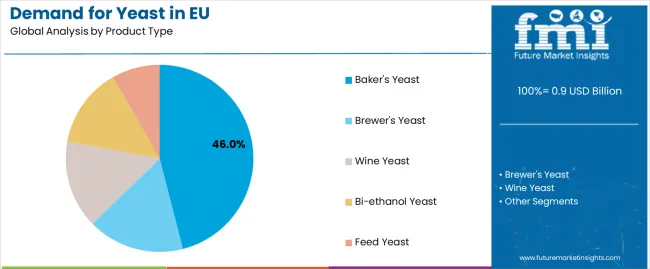
The baker's yeast segment is projected to account for 46% of EU yeast sales in 2025, declining slightly to 44% by 2035, establishing itself as the dominant product type across European bakery operations. This commanding position is fundamentally supported by baker's yeast's essential role in bread production, comprehensive application versatility from commercial bakeries to artisanal operations, and superior leavening performance enabling consistent product quality. The baker's yeast segment delivers exceptional commercial appeal, providing bakeries with a fermentation solution that facilitates production reliability, product consistency, and quality assurance essential for commercial baking operations.
This segment benefits from mature production technologies, well-established distribution networks, and extensive adoption from commercial bakeries, artisanal bread-makers, and industrial baking facilities who maintain rigorous quality standards and continuous strain optimization. Baker's yeast offers versatility across various baking applications, including white bread production, whole grain formulations, sweet dough products, and frozen dough systems, supported by proven fermentation technologies that address traditional challenges in fermentation speed and flavor development.
The baker's yeast segment is expected to maintain its dominant position through 2035, though declining slightly to 44% share as bioethanol yeast applications expand for renewable fuel production throughout the forecast period.
Key advantages:
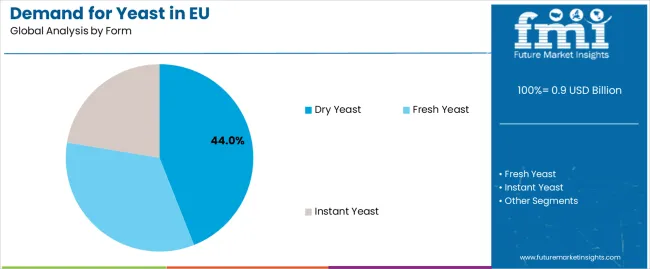
Dry yeast formats are positioned to represent 44% of total yeast demand across European operations in 2025, declining slightly to 42% by 2035, reflecting the segment's position as the preferred format for industrial and home baking applications. This considerable share directly demonstrates that dry yeast represents the plurality preference, with commercial bakeries, foodservice operators, and home bakers utilizing dehydrated yeast formats for extended shelf-life, storage convenience, and reliable fermentation performance.
Modern bakery operations increasingly view dry yeast as a practical alternative to fresh yeast, driving demand for products optimized for storage stability with appropriate moisture content, controlled particle size, and fermentation activity that resonates across diverse baking applications. The segment benefits from continuous innovation focused on instant activation technologies, improved fermentation speed, and packaging solutions enhancing product preservation and handling convenience.
The segment's stable share reflects balanced competition with fresh and instant formats, with dry yeast maintaining its plurality position as storage convenience and shelf-life advantages continue supporting commercial adoption throughout the forecast period.
Key drivers:
Bakery applications are strategically estimated to control 48% of total European yeast sales in 2025, declining slightly to 45% by 2035, reflecting the critical importance of yeast for bread production and baked goods manufacturing throughout European food culture. European bakery operators consistently demonstrate strong demand for yeast that delivers reliable leavening, consistent fermentation, and quality bread characteristics across artisanal bakeries and industrial baking facilities.
The segment provides essential functionality through bread volume development, crumb structure formation, and flavor enhancement that defines bread quality and consumer acceptance. Major European bakery chains, artisanal bread-makers, and industrial baking companies, including European baking groups, premium bread brands, and retail bakery operations, systematically incorporate specialized baker's yeast selections, often featuring proprietary strain formulations, performance-optimized varieties, and application-specific products that ensure bread quality and production consistency.
The segment's gradually declining share reflects diversification into bioethanol applications, with bakery maintaining its dominant 45% position as bread consumption and artisanal baking trends continue driving category development throughout the forecast period.
Success factors:
B2B/Industrial distribution channels are strategically positioned to contribute 72% of total European yeast sales in 2025, declining slightly to 70% by 2035, representing direct supply relationships between yeast manufacturers and large-scale industrial users, commercial bakeries, and brewing facilities. These B2B channels successfully deliver bulk supply reliability and technical support while ensuring consistent quality specifications across industrial applications that prioritize fermentation performance and production efficiency over consumer packaging convenience.
B2B/Industrial distribution serves commercial bakeries, brewing facilities, and bioethanol plants that require reliable yeast supply with validated fermentation characteristics, technical application support, and customized strain specifications. The segment derives significant competitive advantages from established supplier partnerships, technical service capabilities, and the ability to meet substantial volume requirements from major industrial users without consumer packaging constraints limiting bulk delivery efficiency.
The segment's gradually declining share through 2035 reflects growing retail and foodservice penetration, which expand from 28% in 2025 to 30% in 2035, as home baking trends and foodservice baking operations increasingly adopt packaged yeast products and smaller-format supplies.
Competitive advantages:
Conventional yeast products are strategically positioned to contribute 86% of total European sales in 2025, declining to 82% by 2035, representing products produced through standard fermentation processes without organic certification requirements. These conventional products successfully deliver reliable fermentation performance and consistent quality while ensuring broad commercial availability across all distribution channels that prioritize production scalability and cost competitiveness over organic certification.
Conventional production serves price-conscious bakeries, mainstream brewing applications, and volume-oriented industrial users that require effective yeast products at competitive price points compared to organic alternatives. The segment derives significant competitive advantages from established production infrastructure, economies of scale in fermentation facilities, and the ability to meet substantial volume requirements from major industrial users without organic substrate constraints limiting raw material sourcing options.
The segment's declining share through 2035 reflects the category's evolution toward organic products, which grow from 14% in 2025 to 18% in 2035, as quality-conscious bakers and craft brewers increasingly prioritize organic certification and natural production methods.
Competitive advantages:
EU yeast sales are advancing steadily due to increasing artisanal bakery growth, expanding craft brewing culture, and rising bioethanol production capacity. The industry faces challenges, including supply chain cold-chain requirements for fresh yeast preservation, temperature sensitivity concerns affecting product viability, and craft brewing demand volatility impacting specialty yeast requirements. Continued innovation in strain development and fermentation optimization remains central to industry development.
The rapidly accelerating growth of craft brewing and artisanal baking sectors is fundamentally transforming yeast demand from commodity fermentation products to specialized strain solutions, enabling flavor profiles and fermentation characteristics previously unattainable through standard baker's and brewer's yeast alone. Advanced strain development platforms featuring specialized Saccharomyces cerevisiae varieties, wild yeast cultures, and hybrid fermentation systems allow brewers and bakers to create distinctive products with unique flavor complexity, authentic fermentation character, and premium quality positioning comparable to traditional artisanal methods. These specialized innovations prove particularly transformative for craft breweries, artisanal bakeries, and premium food producers, where fermentation character proves essential for product differentiation.
European bioethanol producers systematically incorporate specialized fermentation yeast strains across ethanol production facilities, renewable fuel manufacturing operations, and biofuel programs that deliver efficient carbohydrate conversion, robust fermentation performance, and production cost optimization comparable to conventional fuel production methods. Strategic integration of bioethanol yeast optimized for industrial fermentation enables producers to address renewable energy objectives where fermentation efficiency directly determines production economics. These bioethanol expansions prove essential for renewable fuel positioning, as environmental policy compliance and sustainability targets demand validated fermentation performance, production efficiency, and cost competitiveness supporting biofuel mandates.
European bakers and home cooking enthusiasts increasingly prioritize instant yeast formats featuring rapid activation characteristics, no-pre-fermentation requirements, and convenient handling properties that differentiate modern yeast products through time-saving benefits and usage simplicity. This instant yeast trend enables manufacturers to drive consumer adoption through convenience positioning, production efficiency improvements, and application simplicity resonating with time-conscious bakers seeking fermentation reliability without traditional yeast preparation requirements. Instant yeast adoption proves particularly important for home baking markets where convenience factors drive category engagement and baking frequency.
The development of advanced instant yeast technologies, including rapid-rise formulations, freeze-dried formats, and direct-addition systems expands manufacturers' abilities to create user-friendly products delivering reliable fermentation performance without activation steps. Brands collaborate with baking educators, culinary experts, and recipe developers to develop instant yeast formats balancing convenience with fermentation quality, supporting premium pricing and consumer loyalty while maintaining baking performance credentials across home and professional baker segments.
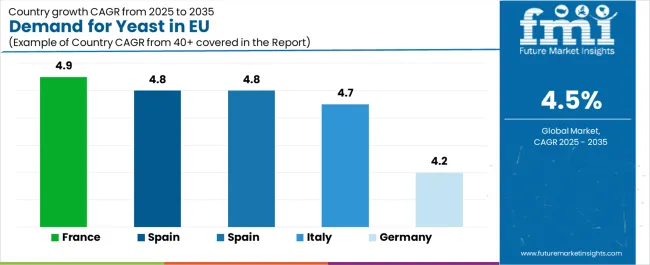
| Country | CAGR % (2025-2035) |
|---|---|
| France | 4.9% |
| Spain | 4.8% |
| Netherlands | 4.8% |
| Italy | 4.7% |
| Germany | 4.2% |
EU yeast sales demonstrate solid growth across major European economies, with France, Spain, and Netherlands co-leading expansion at 4.9% and 4.8% CAGR through 2035, driven by artisanal bakery growth and craft brewing development. Italy shows strong growth at 4.7% CAGR through premium food culture and wine fermentation traditions. Germany records 4.2% CAGR reflecting mature market conditions and established industry infrastructure. Rest of Europe shows minimal growth at 0.5% CAGR across diverse smaller operations. Overall, sales show consistent regional development reflecting EU-wide bakery modernization and craft beverage trends supporting yeast category expansion.
Revenue from yeast in Germany is projected to exhibit steady growth with a CAGR of 4.2% through 2035, driven by exceptionally well-developed baking industry infrastructure, comprehensive brewing heritage, and strong industrial fermentation capabilities throughout the country. Germany's sophisticated bread culture and internationally recognized leadership in baking excellence are creating substantial demand for diverse yeast varieties across commercial and artisanal bakery segments.
Major bakery chains, brewing companies, and industrial fermentation facilities systematically incorporate specialized yeast selections, often dedicating extensive quality assurance resources to fermentation product verification and positioning yeast sourcing as critical to product quality. German demand benefits from high bread consumption, substantial craft brewing sector supporting specialty yeast adoption, and cultural bread traditions that naturally support premium yeast demand across professional bakers beyond basic commodity applications.
Growth drivers:
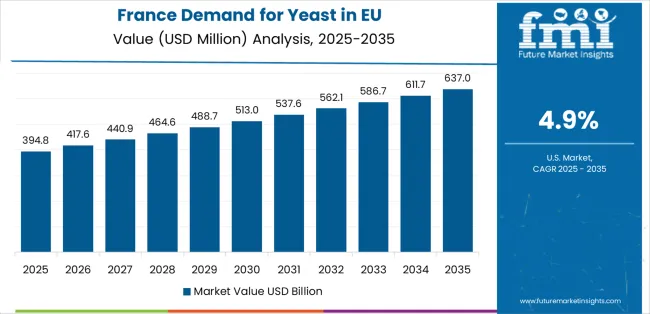
Revenue from yeast in France is expanding at a leading CAGR of 4.9%, supported by strong artisanal bakery culture, expanding craft brewing sector, and premium bread traditions despite France's mature baking market. France's exceptional bread heritage among European nations and iconic boulangerie traditions are driving sustained demand for quality yeast products across diverse bakery applications.
Major bakery operations, artisanal boulangeries, and craft brewing facilities systematically establish comprehensive yeast sourcing strategies to serve continuously growing quality requirements. French sales particularly benefit from stringent bread quality standards demanding superior fermentation characteristics, driving strain innovation and quality assurance within the yeast category. Artisan baker preferences and traditional baking method preservation significantly enhance premium yeast adoption despite industrial baking consolidation.
Success factors:
Revenue from yeast in Italy is growing at a robust CAGR of 4.7%, fundamentally driven by premium bakery sector growth, expanding artisanal baking operations, and traditional bread culture preservation across Italian regions. Italy's strong baking traditions and increasing artisanal food focus are gradually driving demand for quality yeast products as bakers emphasize product authenticity and traditional fermentation methods.
Major bakery companies, artisanal bread-makers, and pizza producers strategically invest in yeast quality improvement and fermentation optimization programs to address growing consumer expectations for authentic products. Italian sales particularly benefit from pizza production requirements, creating natural adoption among quality-focused pizzerias, combined with regional bread specialties in Rome, Milan, and other major cities contributing to expansion through traditional baking preservation.
Development factors:
Demand for yeast in Spain is projected to grow at a leading CAGR of 4.8%, substantially supported by bakery industry modernization, expanding craft brewing sector, and growing artisanal bread culture among Spanish consumers. Spanish bakery evolution and increasing quality consciousness position yeast as aligned with food industry development and premium product growth.
Major bakery chains, craft breweries, and artisanal baking operations systematically expand yeast quality standards and fermentation optimization, with Spanish producers proving particularly successful in adopting premium yeast products through quality improvement initiatives and craft beverage development. Spain's growing artisanal food culture supports specialty yeast adoption among quality-conscious bakers seeking reliable fermentation and traditional bread characteristics.
Growth enablers:
Demand for yeast in the Netherlands is expanding at a leading CAGR of 4.8%, fundamentally driven by strong food technology innovation culture, advanced bakery operations, and comprehensive quality standards supporting premium yeast adoption across professional baking and brewing channels. Dutch food industry demonstrates particularly high receptivity to fermentation innovation and willingness to adopt advanced yeast strains for quality improvement and product differentiation.
Netherlands sales significantly benefit from well-developed food science infrastructure, including advanced fermentation research programs, modern bakery facilities, and innovative brewers testing new strains in a progressive Dutch market environment. The country's food innovation leadership coexists with strong bakery traditions, as bakers increasingly seek quality improvements. The Netherlands also serves as innovation testing ground for European yeast applications, with successful Dutch strain development often expanding to broader European operations.
Innovation drivers:
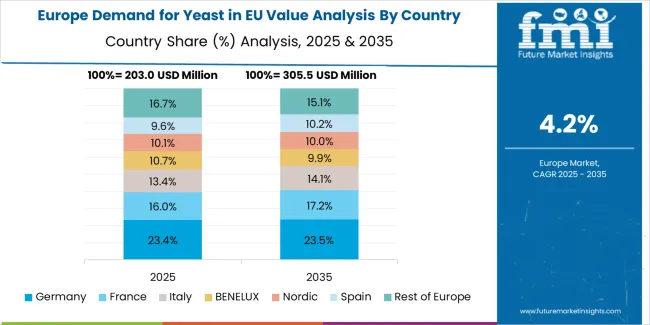
EU yeast sales are projected to grow from USD 0.9 billion in 2025 to USD 1.3 billion by 2035, registering a CAGR of 4.5% over the forecast period. France, Spain, and the Netherlands are expected to demonstrate the strongest growth trajectory with a 4.8% CAGR each, supported by expanding artisanal bakery sectors, growing craft brewing cultures, and bioethanol production expansion. Italy follows with 4.7% CAGR, attributed to premium bakery development and wine fermentation requirements.
Germany maintains the largest share at 28.2% in 2025, driven by established baking industry infrastructure and strong brewing traditions, while growing at a 4.2% CAGR. The rest of Europe demonstrates significantly slower growth at 0.5% CAGR, reflecting diverse regional development stages and market maturity variations.
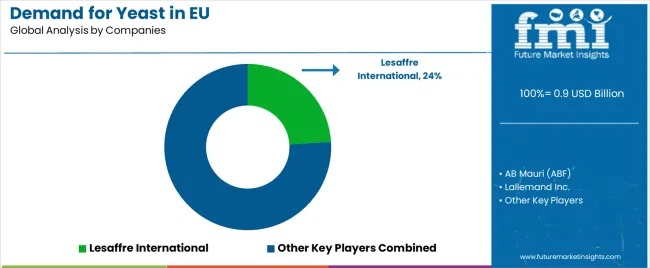
EU yeast sales are defined by competition among established fermentation companies, specialized yeast manufacturers, and ingredient suppliers. Companies are investing in strain development programs, fermentation optimization technologies, application support services, and quality assurance initiatives to deliver high-quality, application-optimized, and consistently performing yeast solutions. Strategic partnerships with bakery operators, brewing facilities, and bioethanol producers, alongside distribution expansion initiatives and technical education campaigns emphasizing fermentation reliability and performance optimization are central to strengthening competitive position.
Major participants include Lesaffre International with an estimated 24% share, leveraging its comprehensive fermentation expertise, global yeast production capabilities, and established European presence through extensive bakery and brewing operations. Lesaffre benefits from comprehensive distribution networks, technical fermentation knowledge, and ability to position specialized yeast strains alongside application support services, supporting mainstream adoption and professional baker relationships.
AB Mauri (ABF) holds approximately 18% share, emphasizing diverse bread ingredient portfolio across multiple markets, strong European distribution infrastructure, and baking expertise supporting product development. AB Mauri's success in developing comprehensive baking solutions with integrated yeast offerings creates strong positioning and baker acceptance, supported by technical capabilities and ingredient supply expertise.
Lallemand Inc. accounts for roughly 12% share through its position as specialized fermentation company with brewing yeast expertise, providing application-optimized strains through technical-driven development. The company benefits from brewing industry relationships, specialized strain collections, and comprehensive technical support helping brewers understand fermentation characteristics, supporting craft brewing positioning and specialty application focus.
Angel Yeast represents approximately 8% share, supporting growth through expanding European sales network, competitive pricing strategies, and production scale advantages across Asian manufacturing operations. Angel Yeast leverages cost-effective production capabilities applied to European market penetration, quality certification development, and distribution expansion, attracting price-conscious industrial users seeking reliable yeast supply with competitive economics.
Kerry Group and DSM/Firmenich collectively hold 11% share, reflecting specialized positioning within nutritional yeast and yeast extract applications, where ingredients expertise and biotech capabilities serve specific industrial requirements beyond traditional baking and brewing applications.
Other companies collectively hold 27% share, reflecting competitive dynamics within European yeast sales, where numerous regional producers, specialized fermentation companies, private-label suppliers for bakery chains, and emerging biotech companies serve specific application requirements, local operations, and niche fermentation needs. This competitive environment provides opportunities for differentiation through specialized strains, organic certification, custom fermentation capabilities, and application-specific positioning resonating with artisanal bakers and craft brewers seeking distinctive fermentation solutions.
| Item | Value |
|---|---|
| Quantitative Units | USD 1.3 billion |
| Product Type | Baker's Yeast, Brewer's Yeast, Wine Yeast, Bi-ethanol Yeast, Feed Yeast |
| Form | Dry Yeast, Fresh Yeast, Instant Yeast |
| Application | Bakery, Brewing, Wine, Bioethanol, Animal Feed, Nutritional/Functional |
| Distribution Channel | B2B/Industrial, Foodservice, Retail |
| Nature | Conventional, Organic |
| Countries Covered | Germany, France, Italy, Spain, the Netherlands, and the Rest of Europe |
| Key Companies Profiled | Lesaffre International, AB Mauri, Lallemand Inc., Angel Yeast, Kerry Group, DSM/Firmenich, Specialized manufacturers |
| Additional Attributes | Dollar sales by product type, form, application, distribution channel, and nature; regional demand trends across major European economies; competitive landscape analysis with established fermentation companies and specialized yeast manufacturers; professional preferences for various yeast strains and formats; integration with fermentation technologies and strain development programs; innovations in instant yeast convenience and organic certification; adoption across bakery, brewing, and bioethanol channels; regulatory framework analysis for food-grade yeast standards and fermentation safety requirements; supply chain strategies including cold-chain management; and penetration analysis for commercial bakeries, craft brewers, and bioethanol facilities across European markets. |
The global demand for yeast in EU is estimated to be valued at USD 0.9 billion in 2025.
The market size for the demand for yeast in EU is projected to reach USD 1.3 billion by 2035.
The demand for yeast in EU is expected to grow at a 4.5% CAGR between 2025 and 2035.
The key product types in demand for yeast in EU are baker's yeast, brewer's yeast, wine yeast, bi-ethanol yeast and feed yeast.
In terms of form, dry yeast segment to command 44.0% share in the demand for yeast in EU in 2025.






Our Research Products

The "Full Research Suite" delivers actionable market intel, deep dives on markets or technologies, so clients act faster, cut risk, and unlock growth.

The Leaderboard benchmarks and ranks top vendors, classifying them as Established Leaders, Leading Challengers, or Disruptors & Challengers.

Locates where complements amplify value and substitutes erode it, forecasting net impact by horizon

We deliver granular, decision-grade intel: market sizing, 5-year forecasts, pricing, adoption, usage, revenue, and operational KPIs—plus competitor tracking, regulation, and value chains—across 60 countries broadly.

Spot the shifts before they hit your P&L. We track inflection points, adoption curves, pricing moves, and ecosystem plays to show where demand is heading, why it is changing, and what to do next across high-growth markets and disruptive tech

Real-time reads of user behavior. We track shifting priorities, perceptions of today’s and next-gen services, and provider experience, then pace how fast tech moves from trial to adoption, blending buyer, consumer, and channel inputs with social signals (#WhySwitch, #UX).

Partner with our analyst team to build a custom report designed around your business priorities. From analysing market trends to assessing competitors or crafting bespoke datasets, we tailor insights to your needs.
Supplier Intelligence
Discovery & Profiling
Capacity & Footprint
Performance & Risk
Compliance & Governance
Commercial Readiness
Who Supplies Whom
Scorecards & Shortlists
Playbooks & Docs
Category Intelligence
Definition & Scope
Demand & Use Cases
Cost Drivers
Market Structure
Supply Chain Map
Trade & Policy
Operating Norms
Deliverables
Buyer Intelligence
Account Basics
Spend & Scope
Procurement Model
Vendor Requirements
Terms & Policies
Entry Strategy
Pain Points & Triggers
Outputs
Pricing Analysis
Benchmarks
Trends
Should-Cost
Indexation
Landed Cost
Commercial Terms
Deliverables
Brand Analysis
Positioning & Value Prop
Share & Presence
Customer Evidence
Go-to-Market
Digital & Reputation
Compliance & Trust
KPIs & Gaps
Outputs
Full Research Suite comprises of:
Market outlook & trends analysis
Interviews & case studies
Strategic recommendations
Vendor profiles & capabilities analysis
5-year forecasts
8 regions and 60+ country-level data splits
Market segment data splits
12 months of continuous data updates
DELIVERED AS:
PDF EXCEL ONLINE
Europe Yeast Extract Market Trends – Growth, Demand & Forecast 2025–2035
Western Europe Yeast Market Analysis by Type, Form, and Country Through 2025 to 2035
Demand for Yeast-Based Spreads in EU Size and Share Forecast Outlook 2025 to 2035
Europe Radiotherapy Patient Positioning Market Size and Share Forecast Outlook 2025 to 2035
Europe Polyvinyl Alcohol Industry Analysis Size and Share Forecast Outlook 2025 to 2035
Europe Cruise Market Forecast and Outlook 2025 to 2035
Europium Market Forecast and Outlook 2025 to 2035
Eucommia Leaf Extract Market Size and Share Forecast Outlook 2025 to 2035
Europe Massage Therapy Service Market Size and Share Forecast Outlook 2025 to 2035
Yeast Beta Glucan Market Size and Share Forecast Outlook 2025 to 2035
Europe Cement Market Analysis Size and Share Forecast Outlook 2025 to 2035
European Union Tourism Industry Size and Share Forecast Outlook 2025 to 2035
Europe Injection Molding Machines Market Size and Share Forecast Outlook 2025 to 2035
Europe Injection Moulders Market Size and Share Forecast Outlook 2025 to 2035
Europe and MENA Generic Oncology Drug Market Size and Share Forecast Outlook 2025 to 2035
Europe Masking Tapes Market Size and Share Forecast Outlook 2025 to 2035
Europe Liners Market Size and Share Forecast Outlook 2025 to 2035
Europe Dermal Fillers Market Size and Share Forecast Outlook 2025 to 2035
Europe Trolley Bus Market Size and Share Forecast Outlook 2025 to 2035
EU Battery Passport Solutions Market Analysis - Size, Share, and Forecast Outlook 2025 to 2035

Thank you!
You will receive an email from our Business Development Manager. Please be sure to check your SPAM/JUNK folder too.
Chat With
MaRIA